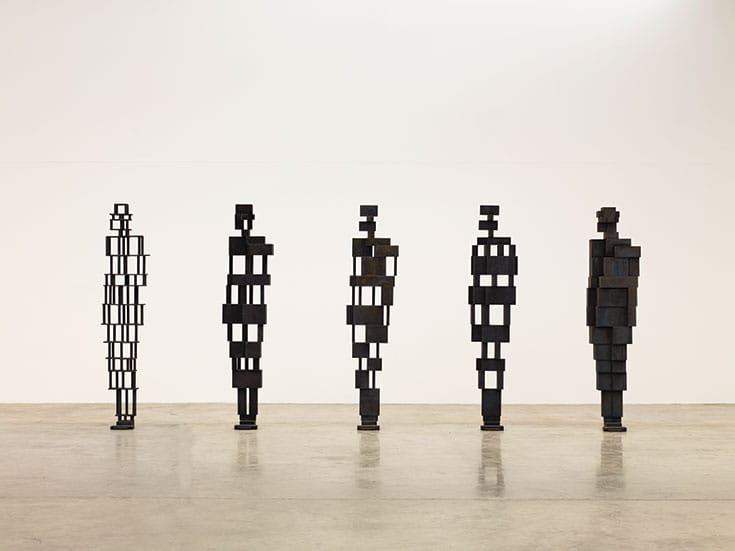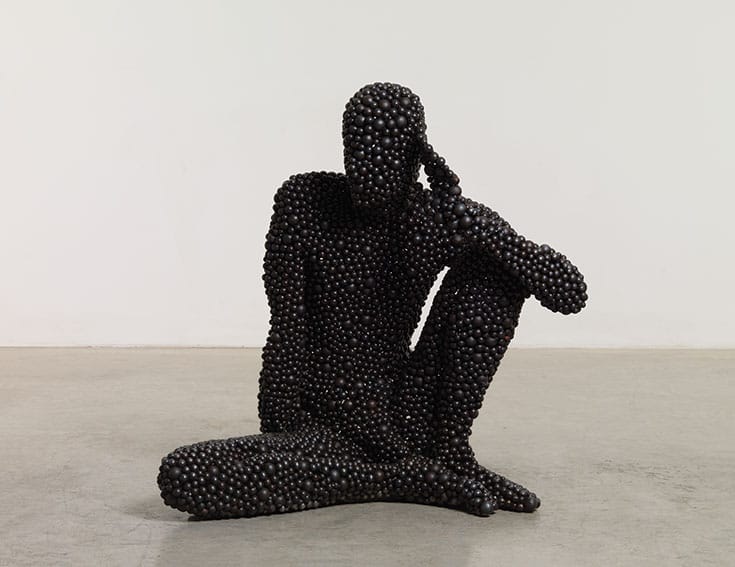William James, one of the founders of modern psychology, wrote in 1890 that our earliest experience of the world is of “a great blooming, buzzing confusion.” While modern research shows that newborns have more ability to make sense of their experience than James believed, even as adults we remain confused about how our minds work. Yes, we all know that we have minds and psychological experiences, but who are we really? How does mind work to shape our experience of our world, our felt experience of being alive? How might we slow down for a moment to see clearly the dazzlingly rapid unfolding of mind and world?
Buddhist psychology begins by examining our everyday experience of clarity and confusion about our minds and self. The earliest Buddhist maps of our sense of self show five key steps in the process of ego development. The Sanskrit word for these five, the skandhas, literally means “aggregates” or “heaps.”
The skandhas are not so much collections of elementary particles of existence as momentary gatherings of mental and physical events. In fact, mind and body—the mental and the physical—are the two main kinds of events. We experience ourselves as embodied beings in a world of other physical forms like trees and cars. We also move in a world of other living beings with their own mental experiences of suffering and ease.
The five skandhas, the “heaps” of our basic being, are (1) form, (2) feeling, (3) perception, (4) concept, and (5) consciousness. Let’s walk together now through these five and examine how, step-by-step, they build our sense of self.
Form
The first skandha is called “form,” meaning both our physical body and the body of the world. How is this part of our experience of mind?
Form is the ground of our being, the fundamental sense that we are this body, somewhat separate from this mind. This separation is the primary distinction in our ordinary experience. My body has weight that appears on the bathroom scale in the morning, while my thoughts are of uncertain substance. They matter, particularly to me, but they are not material. My body and my mind arise together, but in uneasy tension. I cannot simply think my weight up or down.
The body and mind are like two quarreling but conjoined siblings.
As in any dualistic relationship, body and mind may go along harmoniously for a time together, enjoying each other’s company and friendship. But body and mind can also fall into deep division, quarrels, and entrenched separations. When all is going well, my body cooperates with what my mind seems to want from it: “Let’s have breakfast now, shall we?” But sometimes my body rebels, developing a knee ache just when I wanted to go for a run or falling asleep during an important meeting.
The body and mind are like two quarreling but conjoined siblings. If we are physically tired or hungry, our experience and judgment of others may be correspondingly flavored by fatigue or low blood sugar. A recent study showed that Israeli judges granted parole in sixty-five percent of cases heard immediately after they had eaten and in nearly zero cases heard just before a break period or at the end of the day. So the first insight into the working of our minds is that understanding mental experience requires close attention to the skandha of form as well.

Feeling
The next phase in the emergence of self is called “feeling.” This means our basic sense of liking, disliking, or being indifferent to whatever we perceive.
How do we feel about the forms and beings we are encountering? Do they feel attractive or threatening? Do we feel like moving toward or away from them? These intuitive feelings—not quite full-fledged emotions—are the basis for our subsequent impulses toward or away from whatever we are experiencing. “A warm sweater in winter? Hmm, good, I like this very much.” “Too many layers in the heat of the midday sun? Hmm, bad, I’d like to take some of these off.” Like, dislike, attraction, repulsion, neutrality—around and around we go all day and all night. Daydreams and nightmares are all flavored by feeling.
Feeling is the general background to all our experience, a changing texture of encounter and exchange with our world. This is not denying that there are benevolent and malevolent beings in the world, those who wish us well and those who would cause us harm. As they say, “Even paranoids have real enemies.”
Note that these feelings are our mental experience. It’s partly the delight of our own minds we are tasting when we enjoy a delicious apple. The skandha of feeling points to this primarily mental aspect of all our experience. Our own minds accompany our experience of anything and everything. This sounds obvious at first, barely worth mentioning, but it’s one of the key insights of the contemplative traditions. Our pleasant or unpleasant experiences of whomever or whatever always have an inner aspect. We call this inner aspect “mind.”
Perception
The next stage in the development of the self is called “perception.” These are more specific discernments than the simple, broad-brush evaluations of feeling—thumbs up, thumbs down, or neutral. Here it’s “I like, very much, not only the warmth provided by my new wool sweater but also its light-blue color and smooth texture.” These perceptions of the desirable, handsome qualities of the new sweater are all tinged by biases from the past. We’ve prejudged it as having good qualities based on our prior feelings.
Note that these perceptual judgments are all from my point of view, from the perspective of a gradually solidifying “me.” (A moth’s experience of the sweater would be very different.) We perceive this as “a really good light-blue wool sweater” because, for the moment at least, it seems to be “on my side,” on the side of a central “me.” There is a dawning sense that this sweater fulfills and completes me, so I grasp to hold on to it. It’s as though by holding on tightly to the sweater (substitute whatever fits for you), I am also holding on to a self.
The self-centeredness of this “perceiving” comes home to roost in the psychological payoff: that this sweater makes me good, “good to go,” slightly better than I was without it—and a lot more solid in a fast-changing world.
Our experience of the world arrives conveniently packaged into things we perceive are good for us and things that aren’t.
It’s as though the skandha of perception were an old-fashioned central switchboard operator fearfully screening our telephone calls according to one simple criterion: for me or against me? As a result, our experience of the world arrives conveniently packaged into things we perceive are good for us and things that aren’t. What’s wrong with that?
The problem is that the switchboard operator acts in anxious haste, barely pausing to ask the name of the caller or the nature of the call. The operator quickly—too quickly—decides to let some calls through as “friends” and to deny access to others as “enemies.” This would be tremendously helpful and efficient if it were accurate.
Unfortunately, it’s all too frequently a comic series of painful errors, just a prejudiced guess based on habitual patterns: “Oh, I remember you from the pleasing sound of your voice yesterday, Mr. Smith, you’re a very good friend, let me put you through immediately.” Or “No, I don’t remember you, Mr. Jones, never heard of you, but your ugly voice reminds me of a crank caller yesterday, so please go away, good-bye!” As we see from this analogy, perception adds names and labels of “recognition” based on past experience. We also see corresponding impulses developing to actively grasp or push away our experience.
Our hyper-busy perceptual switchboard operator also fails to take into account the crucial fact of change. We have all had the experience of discovering that the person we were uncertain about yesterday turns out to be a close ally and friend tomorrow—and vice versa. This enlivening discovery of the new is what the “downloading” of past perceptions blocks.

Concept
The developmental process of ego hardens further with the fourth skandha: “concept” or “mental formation.”
With concept, we now have a name for the kind of person Mr. Smith is—“good, pleasing”—and a series of names—“bad, unpleasant”—for the kind of person Mr. Jones represents to us. This is the realm of story lines and ideologies. This is the dualistic aspect of mind that we call “false intellect”—using fixed conceptual categories to identify ourselves and others.
In this realm of distorted insight, we begin cleverly deceiving ourselves based on snap judgments, clouded intuitions, yesterday’s news: “Oh, I see now: I’m this kind of person and you’re that kind of person. So we couldn’t possibly be friends. Good-bye!”
We leave the spacious, open humility of not-knowing far behind and take shelter in a thicket of concepts.
At this stage, we have developed sophisticated interpretations of ourselves and our experience, far beyond the basic “yea” and “nay” of feeling. This is the dimension of psychological explanations: “I am this kind of person, because that happened before.”
Again, this is not to deny the power of previous causes and conditions in shaping the beings we have become. But the temptation is to solidify the flowing water of fresh insight into the frozen ice of fixed mental ideas. I repeat to myself over and over again—and to whoever is willing to listen—old stories of who I am, who I was, and who I am becoming (as well as who you are and why you’re that way). We leave the spacious, open humility of not-knowing far behind and take shelter in a thicket of concepts. Ouch!
Consciousness
Finally, we discover the mental experience of the fifth skandha, “consciousness.” The accumulated momentum of the initial mind–body split, the positive or negative felt sense of others, and the labels of ourselves and our world culminates in a vivid display of emotions and thoughts.
This skandha is the familiar stream of consciousness that we experience in everyday life, our mind-stream. Buddhist psychology breaks it down into eight separate consciousnesses. In addition to the familiar sense consciousnesses of seeing, hearing, smelling, tasting, and touching, Buddhist psychology adds a sixth sense consciousness of “minding.” Just as visual consciousness notices sights and auditory consciousness attends to sounds, this sixth consciousness of mind attends to thoughts and emotions. It also synthesizes and integrates the experience of the other consciousnesses into a coherent whole, like a skillful film editor coordinating image, sound, and discursive commentary.
Underlying these six sense consciousnesses, we may sometimes glimpse two more consciousnesses: a winding, subconscious stream of conflicting emotions and anxiety (the klesha, or “nuisance consciousness”) and even a hazy background awareness (the alaya, or “storehouse consciousness”) that we sometimes look back toward and call “I.” These underground currents are great instigators, bubbling up occasionally with old resentments and jealousies, fixated passions, and strongly motivated denials.
The skandha of consciousness completes the development of a deluded ego-sense. We now feel separate, independent, and unitary—even though there is ample evidence to the contrary.
Far from being single, unitary beings, we arise as a dynamic collection of physical and mental happenings.
We are not separate from our environments. If we were, how could we breathe, eat, drink, sustain ourselves? Where did the language we speak and write and read come from? None of us is self-produced and independent, as our mothers and fathers remind us. And far from being single, unitary beings, we arise as a dynamic collection of physical and mental happenings, including breathing, sleeping, dreaming, and waking. We have emotional and physiological, skeletal and psychological aspects to our being, and although these occasionally conflict with each other, they also cooperate and harmonize.
What You Can Learn from the Skandhas
Insight into your own psychological processes—into how your mind works—is not an end in itself. The tradition doesn’t offer this teaching as mere intellectual knowledge or information. You are encouraged to use this map to become more and more familiar, through direct experience, with the processes you call “me” and “my mind.”
Developing a harmonious friendship with yourself is a central part of the Buddhist path of awakening. These teachings on the five skandhas invite you into a deeper, more intimate experience of yourself. What do you find when you look into your own experience of body and mind? This isn’t about dogma—the point isn’t to confirm that the map is accurate or “correct.” Part of the point is to notice that the map is not the territory and never could be. (Imagine a map of Canada that was the size of Canada: how useless would that be?) You are invited to set forth as explorers of your own inner and outer terrains. Bon voyage.
When you engage in this psychological exploration, one of your best companions will be a sense of friendliness toward yourself and others. Friendliness means taking these five mental processes not as signs of an inherent weakness or fundamental inadequacy but as aspects of your basic humanity. Through cultivating friendliness, you can experience the skandhas (as well as whatever else arises along the way) with a real sense of gratefulness and appreciation. Let me be more specific here.
If you can simply feel your feelings as they arise, without rejecting them or telling yourself stale stories of why you are “right” to feel this way, then feelings emerge as highlights of being human, vivid signs of being alive.
The skandhas point, first, to healing the body–mind split. If you pay caring attention to body and mind as an actual experience, not just a distant “good idea,” then you’ve made a good start. This is traditionally called “mindfulness of body.” It’s a simple sense of welcoming and including your present physical experience—not exaggerating your body or denigrating it, neither praising nor condemning it. This is mind–body friendliness.
The same goes for the other skandhas as well. If you can simply feel your feelings as they arise, without rejecting them or telling yourself stale stories of why you are “right” to feel this way, then feelings emerge as highlights of being human, vivid signs of being alive. You don’t need to act them out or repress them. This is spacious freedom. Beyond grasping and fixation, you allow your feelings to arise, be present, and go. You appreciate that life bubbles up as colorful emotions, as heartfelt experience. You appreciate being human.
Similarly, your thoughts and ideas can be seen as the liberating play of wisdom. If you notice your thoughts as thoughts, rather than confusing them with reality, then they become friends and allies, companions along the path. Instead of confining your consciousness of sense perceptions in narrow, tight boxes of “for me” or “against me,” you can open into a larger appreciation of seeing and hearing. You can taste the vastness of your world.
On this journey, you see that both clarity and confusion are woven into your everyday experience of mind. The skandhas illuminate a fivefold process of mind grasping and fixating, engaging in a losing battle of ego against the world. Yet the same mental events can be the basis for a cease-fire, an entrance into non-struggle and luminous peace.
Each moment in the unfolding of your experience is an opportunity to welcome yourself, your feelings, your mind, and others in your world. The key to working with mind, to understanding its processes, is found in the innate warmth and friendliness of the mind itself. You don’t need a newer, better, super-improved body–mind. The real challenge is making friends with the mind and body you already are.

